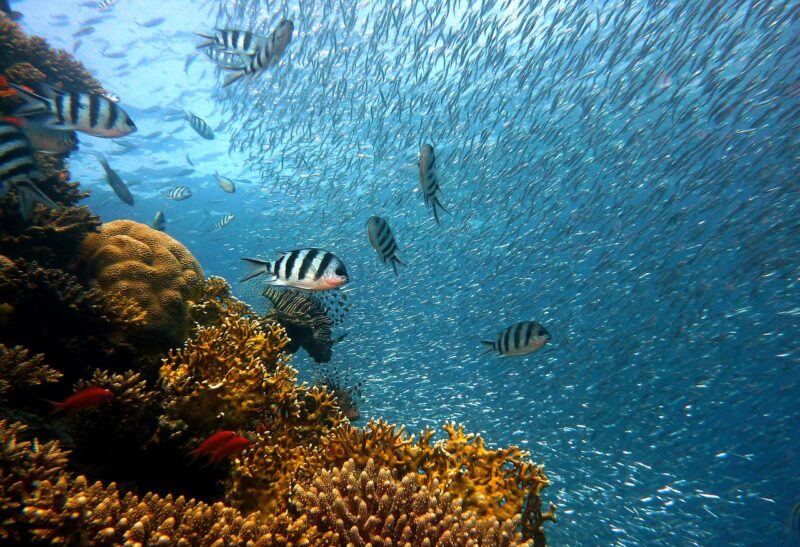How Coral Spawning Helps Rejuvenate Reefs and the Role of Ocean Currents
November 14, 2024

Coral reefs, often referred to as the “rainforests of the sea,” are vital ecosystems that support an incredible diversity of life. They provide food, shelter, and breeding grounds for countless marine species and serve as important barriers that protect coastlines from erosion and storm damage. However, these ecosystems face unprecedented threats due to climate change, pollution, and overfishing. Understanding the mechanisms that help coral reefs regenerate, such as coral spawning, is crucial for their survival and for the health of our oceans.
1. What is Coral Spawning?
Coral spawning is a remarkable reproductive process where corals synchronously release eggs and sperm into the ocean. This event typically occurs once a year, usually following a full moon, and it is the primary way corals reproduce both sexually and asexually. During this phenomenon, male and female corals release their gametes into the water column, where fertilization occurs, leading to the formation of new coral larvae.
The timing of coral spawning can vary based on geographical location and species, but it often coincides with specific environmental cues such as temperature, light, and lunar phases. The synchronization of spawning events enhances the likelihood of successful fertilization and genetic diversity among coral populations.
2. The Process of Coral Spawning: A Closer Look
Coral spawning can be illustrated through the following steps:
- Preparation: In the weeks leading up to spawning, corals prepare by increasing energy reserves, which are essential for the reproductive process.
- Spawning Event: On a specific night, usually after sunset and around the new or full moon, corals release their eggs and sperm in a synchronized manner. This creates a phenomenon known as a “gamete cloud,” where thousands of gametes are dispersed into the water.
- Fertilization: Once released, the gametes float toward the surface and encounter each other. Successful fertilization results in the formation of fertilized eggs or zygotes, which then develop into free-swimming larvae known as planulae.
- Settlement: After spending several days in the water, the planulae eventually settle onto suitable substrates, such as the ocean floor or existing coral structures, where they metamorphose into polyps and begin the process of forming new coral colonies.
This reproductive strategy is crucial not just for coral populations but also for the overall health of marine ecosystems, as it contributes to biodiversity and the resilience of coral reefs.
3. The Role of Ocean Currents in Coral Spawning
Ocean currents play a critical role in the success of coral spawning. These currents are like the “roads” of the ocean, influencing water temperature, salinity, and nutrient distribution. During the spawning period, several factors come into play:
- Transport of Gametes: Ocean currents facilitate the distribution of coral gametes after spawning, increasing the likelihood of fertilization. The swiftness of currents can help transport fertilized eggs away from predators and to areas suitable for settlement.
- Temperature Regulation: Corals are sensitive to temperature fluctuations. Ocean currents help maintain optimal temperatures for coral health and spawning activities by circulating warm and cool water.
- Nutrient Availability: Currents play a role in the dispersal of nutrients, which are essential for the growth of algal symbionts (zooxanthellae) that live within coral tissues. These symbiotic relationships are vital for coral energy production and growth.
- Resilience to Stressors: Healthy ocean currents can help coral reefs withstand environmental stressors, providing them with the necessary conditions for successful spawning and recovery from bleaching events.
4. The Importance of Coral Spawning for Reef Rejuvenation
Coral spawning is fundamental for the rejuvenation of reefs in several ways:
- Genetic Diversity: By allowing for sexual reproduction, coral spawning increases genetic diversity among coral populations. This diversity enhances resilience to diseases, environmental changes, and climate change impacts.
- Colony Growth: The successful settlement of planulae leads to the formation of new colonies, which contribute to the physical structure and complexity of the reef, providing habitat for a plethora of marine organisms.
- Rebuilding Damaged Reefs: After events such as bleaching or storm damage, coral spawning can play a vital role in rebuilding the reef ecosystem, giving a chance for regeneration and recovery.
- Supporting Marine Biodiversity: Healthy and thriving coral reefs foster diverse marine life, which in turn supports local fisheries and global fisheries economies.
With coral reefs declining at alarming rates, understanding and supporting coral spawning and the role of ocean currents is crucial. Initiatives focusing on coral reef conservation, protecting marine habitats, and sustainably managing human activities are paramount to ensure the survival of these vital ecosystems.
5. Conclusion
Coral spawning represents a natural spectacle that embodies the resilience and regeneration of coral reefs. It is a fascinating process intricately linked to the health of marine ecosystems and heavily influenced by ocean currents. As stewards of the planet, it is our responsibility to protect coral reefs from threats and to support their natural rejuvenation processes.
By understanding the critical role that reproductive cycles like coral spawning play in reef resilience and by advocating for sustainable practices, we can help ensure the survival of coral reefs for generations to come. Only through concerted efforts in research, policy-making, and community engagement can we hope to preserve these vibrant and essential ecosystems.






